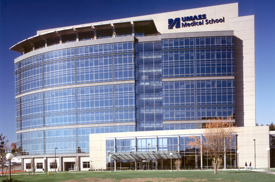 Energy efficiency improvements being made to air-handling systems in the Lazare Research Building will save UMMS approximately $500,000 a year in future utility costs. The project includes re-calibration of the automation system, installation of an air quality monitoring system and upgrading some fume hoods.
Energy efficiency improvements being made to air-handling systems in the Lazare Research Building will save UMMS approximately $500,000 a year in future utility costs. The project includes re-calibration of the automation system, installation of an air quality monitoring system and upgrading some fume hoods.
“Last month we began installing an indoor air quality monitoring system called Aircuity throughout the lab spaces in the building,” explained Melissa Lucas, sustainability and energy manager at UMMS. “This system will allow us to monitor and enhance ventilation rates in the building to achieve the most efficient exchange of indoor and outdoor air. We’ve also begun retrofitting some of the fume hoods in the building to further improve efficiency.”
The project will cost a total of $1.8 million. After the project is completed, UMMS is anticipating energy efficiency rebates of about 50 percent of the project costs from National Grid and NSTAR, the electric and gas providers for the campus. “With the funding from National Grid and NSTAR we will start to see savings in a little more than a year and a half,” said Lucas.
Laboratory ventilation systems account for as much as 60 percent of a research facility’s utility costs. As a result, the Lazare Research Building’s ventilation system and exhaust hoods have been a major focus for potential energy efficiencies. According to Brian McCarthy, assistant director of maintenance, the building uses “100 percent outside air” for its ventilation system, which means fresh air is brought in and used once, before being vented outside again. “Every time air comes into the building, it has to be filtered, heated, cooled and de-humidified. It’s a multi-step operation that consumes lots of energy,” he said. Installation of the new monitoring and ventilation system will greatly reduce utility costs while also improving air quality in the building.
The air quality systems will monitor the concentration of contaminants in lab spaces by taking an air sample every 15 minutes. During periods of high air quality, the sensor can keep the air change rate low, resulting in electric and natural gas savings due to reduced outside airflow requirements. Similarly, some fume hoods will be retrofitted so all are operating at their most efficient airflow rates.
Working in collaboration with UMMS on the project was Joseph Mannarino, a senior technical consultant for National Grid. Mannarino, who has worked with UMMS over the years on a number of efficiency projects including the Sherman Center and PowerPlant upgrade, passed away on July 30, 2013. His talent and energy efficiency expertise will be missed by those who worked closely with him.
These energy conservation improvements were implemented as a result of a 2010 laboratory safety and reduction audit done by Exposure Control Technologies, Inc. (ECTI).